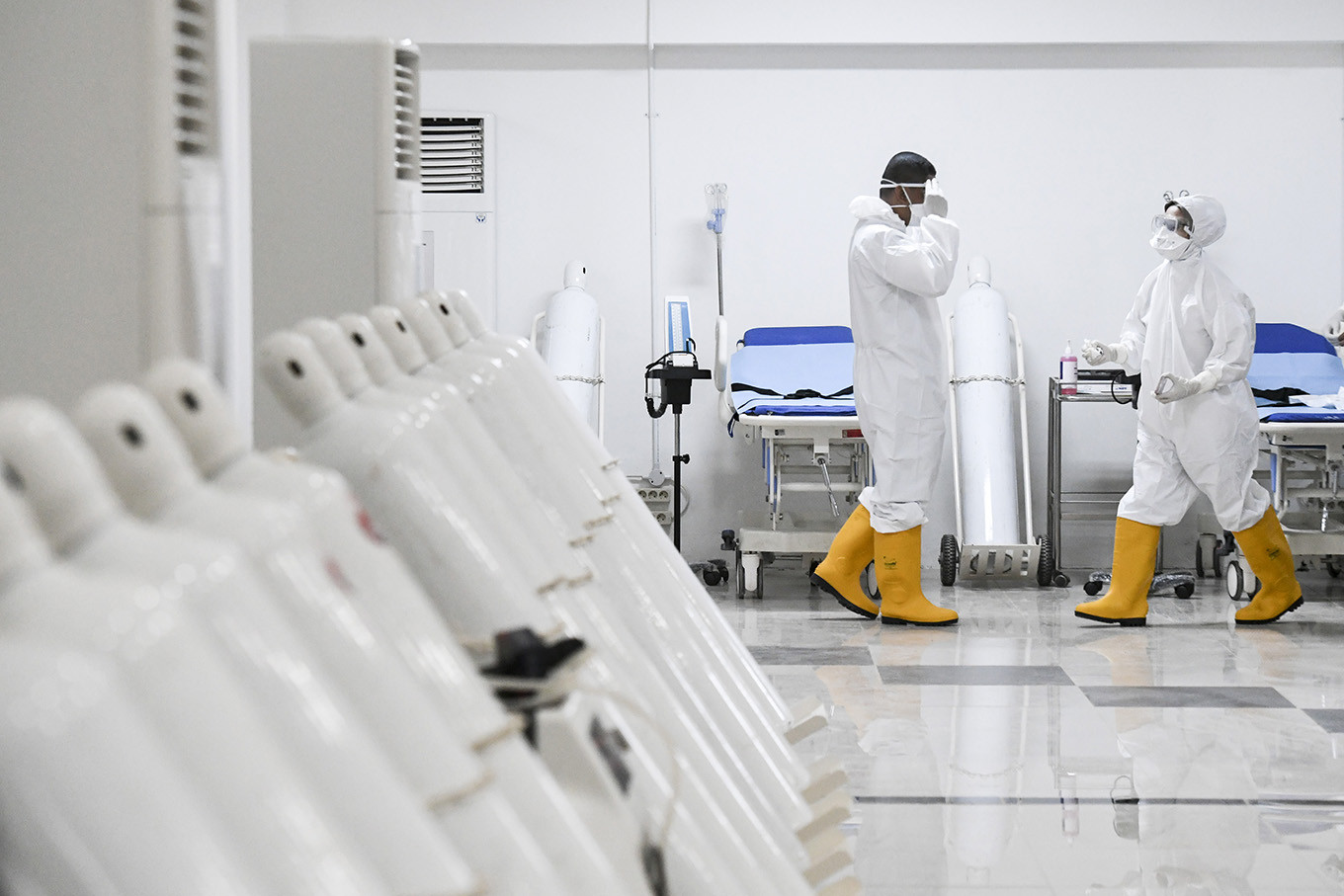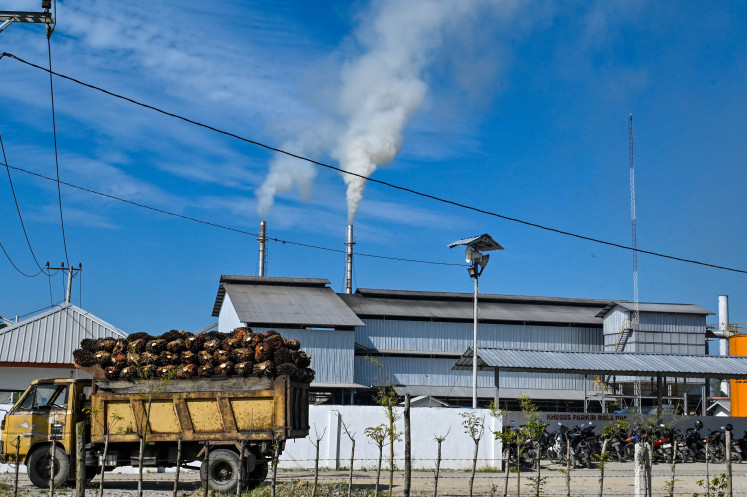Popular Reads
Top Results
Can't find what you're looking for?
View all search resultsPopular Reads
Top Results
Can't find what you're looking for?
View all search resultsPatients crowd hospitals as Indonesia loses 183 'priceless' medical workers
Change text size
Gift Premium Articles
to Anyone
C
OVID-19 patients are crowding hospitals as bone-tired medical workers continue to bear the brunt of rising case figures, with at least 183 of them having reportedly died of the virus.
More than 2,000 daily new cases appears to be the new normal for Indonesia, which on Wednesday recorded 3,075 new cases and 111 deaths -- bringing the tally to 180,646 confirmed cases, 42,877 of which are active cases, and 7,616 deaths.
The daily new cases figure hit record highs of more than 3,000 for three consecutive days last week, partly attributed to recent long weekends.
As people flocked to crowded places, COVID-19 patients swarmed hospitals, prompting fears of a "collapsing healthcare system", as described by senior public health expert Adang Bachtiar of the Indonesian Public Health Experts Association (IAKMI).
"The latest situation is that there has been an escalation of the bed occupancy rate in some hospitals, especially in Jakarta," COVID-19 task force spokesperson Wiku Adisasmito told a press briefing on Tuesday.
He said isolation and ICU bed occupancy rates at the capital city's 67 COVID-19 referral hospitals had reached 69 percent and 77 percent, respectively, on Aug. 28. The government was working on bringing the rates down to below 60 percent, including by sending patients in mild to moderate cases to Wisma Atlet, a makeshift hospital designated for COVID-19.
Read also: Indonesia sees record high in COVID-19 cases for third day running
But Jakarta is not the only one to see such a trend. Data from the Health Ministry's RS Online system obtained by The Jakarta Post show that some regions, though having seen an increase in isolation and ICU bed capacity, saw a spike in occupancy rates over the past week.
The provinces with the highest bed occupancy rates -- even as the number of beds increased -- were Bali, where occupancy increased from 59.44 percent on Aug. 23 to 72.55 percent on Monday, Jakarta (from 54.62 percent to 67.25 percent) and East Kalimantan (from 49.15 percent to 55.62 percent). These were followed by Central Java (from 41.76 percent to 49.30 percent), Banten (from 41.76 percent to 49.30 percent) and East Java (from 44.76 percent to 49 percent).
South and Central Kalimantan saw a slight decrease in the number of COVID-19 beds but their occupancy rates spiked from 53.22 percent to 59.25 percent and from 47.78 percent to 56.58 percent, respectively.
The Aug. 31 data show that Indonesia had a total of 42,435 isolation and ICU beds designated for COVID-19 patients, with 23 provinces each having fewer than 1,000 COVID-19 beds.
The country has 0.4 physicians per 1,000 population, according to World Bank data from 2018, much lower than the Organization for Economic Cooperation and Development (OECD) average of 3.4 in 2017.
Jakarta Governor Anies Baswedan acknowledged on Tuesday that bed occupancy rates had reached "over 70 percent" and that his administration would increase its hospital bed capacity to suppress the rates to "below the ideal of 60 percent". He said it would involve more hospitals as COVID-19 referral hospitals. Jakarta has 190 hospitals according to Anies.
Read also: Jakarta to require all COVID-19 patients to be quarantined in hospitals
"Expanding capacity is not only about [adding] medical devices or rooms; the rooms and medical devices are ready. [It is also about] the human resources," Jakarta Health Agency head Widyastuti said, adding that the city had recruited some 1,800 medical workers ready to be deployed by next week.
Private hospitals had to previously reduce the number of their COVID-19 beds to accommodate non-COVID-19 patients, but the city was still working on involving more private hospitals in the pandemic response, she said.
Jakarta's main COVID-19 referral hospital, Persahabatan Hospital, which is designated for moderate to severe cases, has reported an increase in admissions since late June, with the bed occupancy rate standing at 70 percent on Monday.
Not only hospitals are feeling the strain; some community health centers (Puskesmas) have either been forced to close after their workers contracted the virus or have been running understaffed as some workers went into isolation.
In Subang, West Java, a Puskesmas has been temporarily closed after at least 41 of its workers contracted the virus.
West Java Health Agency head Berli Hamdani said that patients should be honest in disclosing their symptoms to medical workers to suppress health facility transmission, adding that the administration was trying to improve infection control and triage at health facilities.
Read also: Medics dying, infections soaring — it’s still the economy?
At least 104 doctors have died of COVID-19 as of Wednesday, including two final-year resident doctors and Sulis Bayu Sentono, one of only handful pediatric orthopedics in Indonesia, according to the Indonesian Medical Association (IDI).
Twenty-eight of these doctors were based in East Java, 22 in Greater Jakarta, 18 in North Sumatra and the remainder in various regions of the archipelago.
Nine dentists have also died of COVID-19 as of Tuesday, according to the IDI. The Indonesian Nurses Association (PPNI), meanwhile, said 70 nurses have died of the disease as of Monday.
The number of medical workers infected is estimated to reach thousands.
The IDI said it was looking into the deaths, including whether they had comorbidity factors and where they had been providing treatment. The association has previously called for a robust supply of protective personal equipment, better work schedules, routine testing and for hospitals to limit or not deploy workers with high risks and comorbidity factors.
Read also: Jokowi mourns medical workers who have fallen to COVID-19
The death of hundreds of "priceless" medical workers was an unbearable loss to a country with a “poor” doctor-to-population ratio and "uneven distribution of doctors centered in big cities only", said Adang of IAKMI.
Training a doctor required decades of investment, and losing them, in turn, would cost the country also decades of experience and add more burden to the already short-handed medical workers, he said.
"This is a very critical situation; the healthcare system is collapsing. Primary health care is seeing fewer visits; there's much worry. People are afraid of going to Puskesmas, so they go to the hospitals, causing this second layer to be overloaded," Adang said.
With health promotion, specific protection and early diagnosis -- the keys in tackling an outbreak -- remaining weak and the government resorting to knee-jerk reactions, it was inevitable that the situation would lead medical workers to develop fatigue and put them at higher risk of infections.
"Non-COVID-19 patients are affected, too [...]. We're in deep trouble, and we have to find a way out," he said.










